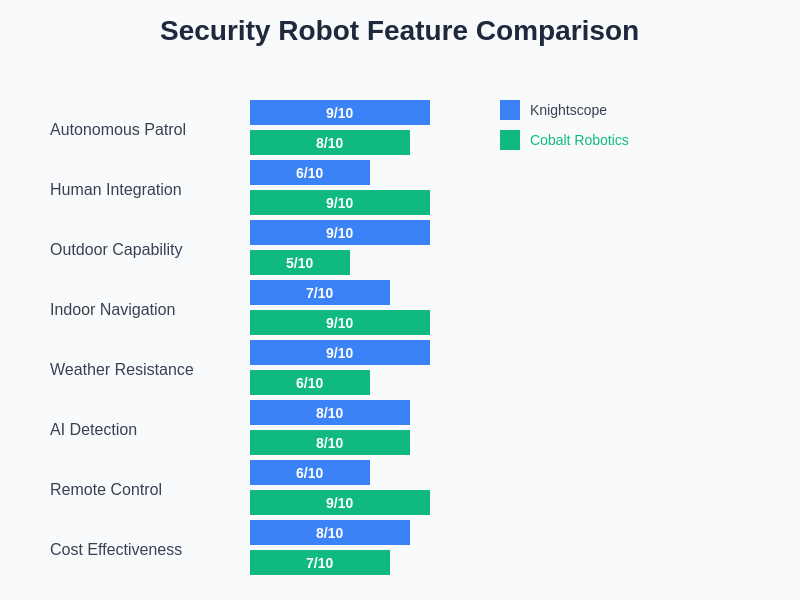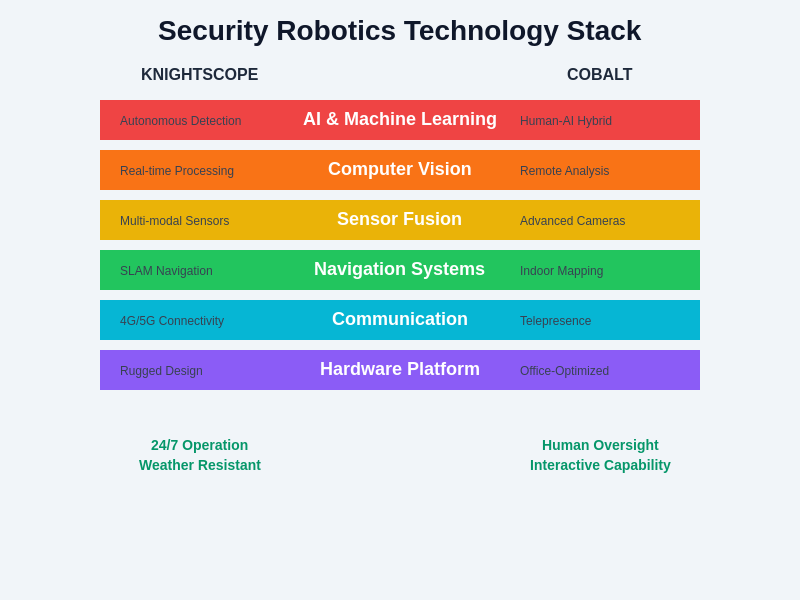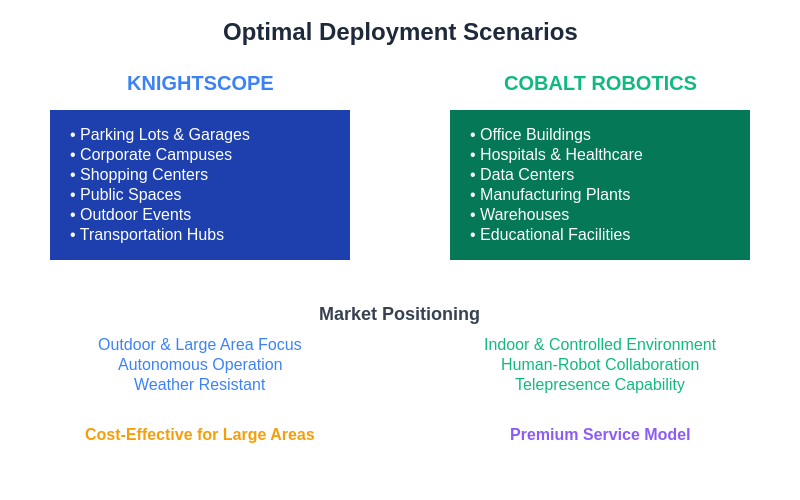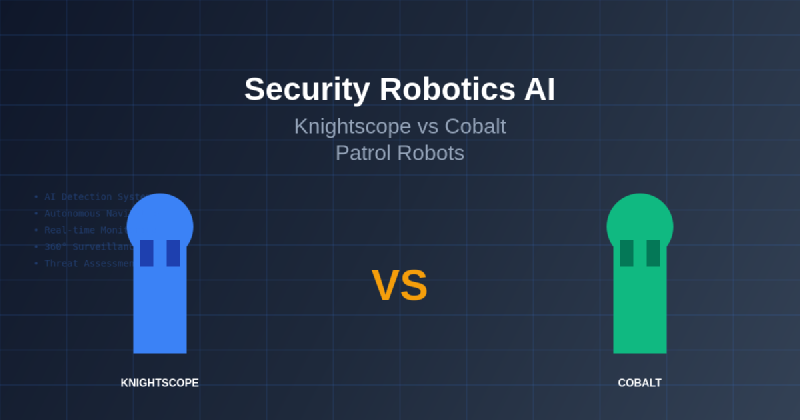The evolution of security technology has reached a transformative milestone with the emergence of autonomous patrol robots powered by sophisticated artificial intelligence systems. Leading this revolution are two prominent platforms that have redefined what it means to provide comprehensive security coverage in modern environments. Knightscope and Cobalt Robotics represent the pinnacle of current security robotics technology, each offering unique approaches to autonomous surveillance, threat detection, and incident response that are reshaping how organizations think about physical security infrastructure.
The integration of advanced AI algorithms, sensor fusion technology, and autonomous navigation systems has enabled these robotic platforms to transcend traditional security limitations, providing continuous monitoring capabilities that exceed human capacity while maintaining cost-effectiveness and operational reliability. This technological advancement represents not merely an enhancement of existing security measures but a fundamental reimagining of how comprehensive security ecosystems can be designed and deployed across diverse environments ranging from corporate campuses to retail facilities and public spaces.
Explore the latest trends in AI security technology to understand how robotics and artificial intelligence are converging to create unprecedented security capabilities that were previously relegated to science fiction but are now becoming essential components of modern security infrastructure.
The Emergence of Autonomous Security Systems
The development of autonomous security robots represents a natural evolution in response to the growing complexity of modern security challenges and the limitations inherent in traditional human-centric security approaches. Organizations worldwide face increasingly sophisticated threats that require continuous vigilance, comprehensive coverage, and rapid response capabilities that strain the resources and effectiveness of conventional security teams. The introduction of AI-powered patrol robots addresses these challenges by providing persistent monitoring capabilities that operate without fatigue, maintain consistent performance standards, and integrate seamlessly with existing security infrastructure to create comprehensive protection ecosystems.
Knightscope and Cobalt Robotics have emerged as industry leaders through their distinct approaches to solving fundamental security challenges. While both companies recognize the importance of autonomous operation and AI-driven threat detection, their technological implementations, deployment strategies, and target markets reflect different philosophies about how robotic security systems should integrate with human security teams and existing infrastructure. This diversity in approach has created a competitive landscape that drives innovation while providing organizations with options that can be tailored to specific security requirements and operational constraints.
The success of these platforms has validated the concept of autonomous security robotics and demonstrated measurable improvements in security effectiveness, operational efficiency, and cost management compared to traditional security approaches. Organizations deploying these systems report enhanced threat detection rates, improved incident response times, and significant reductions in security-related operational costs while maintaining or improving overall security posture and stakeholder confidence.
Knightscope: Pioneering Autonomous Security Patrol
Knightscope has established itself as a pioneer in the autonomous security robot industry through its comprehensive approach to developing self-contained security platforms that operate independently while integrating with existing security infrastructure. The company’s flagship K5 robot represents a mature implementation of autonomous patrol technology that combines advanced sensor arrays, machine learning algorithms, and cloud-based analytics to provide comprehensive security monitoring capabilities that adapt to the specific requirements of different deployment environments.
The design philosophy behind Knightscope robots emphasizes robust autonomous operation with minimal human intervention, utilizing sophisticated navigation systems that enable effective patrol operations across diverse terrain types and environmental conditions. The robots incorporate multiple sensor modalities including high-definition cameras, thermal imaging systems, environmental sensors, and advanced audio processing capabilities that work in concert to detect and analyze potential security threats while maintaining awareness of normal operational patterns and authorized personnel activities.
Experience advanced AI capabilities with Claude for analyzing complex security data and developing sophisticated threat detection algorithms that enhance the effectiveness of autonomous security systems. The integration of multiple AI technologies creates security platforms that can adapt to evolving threat landscapes while maintaining operational reliability and user confidence.
The operational capabilities of Knightscope robots extend beyond simple patrol functions to include comprehensive incident documentation, automated reporting systems, and integration with emergency response protocols that enable rapid escalation of security incidents to appropriate human personnel. The robots maintain detailed logs of all activities, environmental conditions, and detected anomalies that provide valuable intelligence for security analysis and incident investigation while supporting compliance requirements and operational optimization efforts.

The comparative analysis of security robot capabilities reveals distinct strengths and specializations between different platforms, with each system optimized for specific deployment scenarios and operational requirements that determine their effectiveness in various security applications.
Cobalt Robotics: Human-Robot Collaboration Approach
Cobalt Robotics has distinguished itself through a unique approach that emphasizes the complementary relationship between human security professionals and robotic systems rather than pursuing fully autonomous operation. This human-robot collaboration model recognizes that while robots excel at continuous monitoring, pattern recognition, and data collection, human judgment remains essential for complex threat assessment, interpersonal communication, and nuanced decision-making in ambiguous situations.
The Cobalt security robot platform integrates sophisticated AI-driven perception systems with human operator oversight through a remote monitoring center staffed by trained security professionals who can take direct control of robot operations when situations require human intervention. This hybrid approach enables the robots to operate autonomously during routine patrol activities while seamlessly transitioning to human-guided operation when complex situations arise that benefit from human expertise and judgment.
The technological implementation of Cobalt’s approach includes advanced telepresence capabilities that allow remote human operators to interact with on-site personnel through the robot platform, providing a level of human engagement that pure autonomous systems cannot achieve. This capability has proven particularly valuable in environments where human interaction is essential for effective security operations, such as healthcare facilities, educational institutions, and corporate environments where stakeholder comfort and communication are important considerations.
The sensors and AI systems deployed in Cobalt robots focus on providing comprehensive situational awareness to both the autonomous systems and human operators, utilizing high-resolution cameras, environmental monitoring systems, and advanced audio processing to create detailed real-time assessments of security conditions. The integration of human oversight ensures that the sophisticated sensor data is interpreted within appropriate contextual frameworks while maintaining the efficiency benefits of autonomous operation for routine activities.
Technological Capabilities and AI Integration
The artificial intelligence systems powering both Knightscope and Cobalt robots represent sophisticated implementations of machine learning, computer vision, and behavioral analysis technologies that enable these platforms to operate effectively in complex real-world environments. Both systems utilize advanced neural networks trained on extensive datasets to recognize normal patterns of activity, identify potential security threats, and distinguish between routine events and situations requiring attention or intervention.
Computer vision capabilities in both platforms include real-time object detection and classification, facial recognition systems, license plate recognition, and behavioral analysis algorithms that can identify suspicious activities or unauthorized access attempts. These visual processing systems operate continuously and can function effectively in various lighting conditions, weather situations, and environmental contexts while maintaining high accuracy rates and minimizing false positive detections that could overwhelm security teams with unnecessary alerts.
The sensor fusion capabilities of both platforms integrate multiple data sources including visual, thermal, audio, and environmental sensors to create comprehensive situational awareness that exceeds the capabilities of individual sensor modalities. This integrated approach enables the robots to detect threats that might be missed by single-sensor systems while providing corroborating evidence that increases confidence in threat assessments and reduces the likelihood of false alarms or missed detections.
Machine learning algorithms in both systems continuously improve performance through operational experience, adapting to the specific patterns and requirements of individual deployment environments while maintaining compatibility with broader threat detection models. This adaptive capability ensures that the robots become more effective over time while reducing maintenance requirements and operational complexity for security teams.

The technological foundation of modern security robotics integrates multiple layers of sophisticated systems, from artificial intelligence and machine learning at the top level down to robust hardware platforms designed for continuous operation in demanding security environments.
Leverage Perplexity’s research capabilities to stay informed about the latest developments in AI security technology and robotics innovations that are shaping the future of autonomous security systems. The rapid pace of technological advancement in this field requires continuous learning and adaptation to maintain competitive advantages and operational effectiveness.
Deployment Strategies and Market Focus
The deployment approaches employed by Knightscope and Cobalt reflect their different technological philosophies and target market strategies, with each company developing specialized expertise in specific types of security environments and operational requirements. Knightscope has focused primarily on outdoor and semi-outdoor environments such as parking lots, corporate campuses, shopping centers, and public spaces where robust autonomous operation and weather resistance are essential for effective security coverage.
The K5 and other Knightscope models are designed for deployment scenarios where continuous patrol coverage is required across large areas with minimal infrastructure requirements beyond basic charging stations and network connectivity. This approach has made Knightscope robots particularly attractive for organizations seeking to enhance security coverage in areas where human patrol would be expensive, logistically challenging, or insufficient to provide adequate coverage due to size or accessibility constraints.
Cobalt Robotics has concentrated on indoor environments and controlled access facilities where human interaction capabilities and sophisticated environmental monitoring are more important than weather resistance and outdoor autonomy. The company’s robots are commonly deployed in office buildings, hospitals, data centers, and manufacturing facilities where the combination of autonomous monitoring and human oversight provides optimal security effectiveness while maintaining appropriate stakeholder comfort levels.
The different deployment focuses have led to distinct technological optimizations, with Knightscope emphasizing durability, weather resistance, and long-range sensing capabilities while Cobalt prioritizes interpersonal communication systems, indoor navigation precision, and integration with building management systems. These specializations have created complementary market positions that address different aspects of the broader security robotics market.

The strategic positioning of each platform reflects careful consideration of market needs and technological capabilities, with clear differentiation in target environments and operational approaches that maximize the effectiveness of each system within its intended deployment context.
Performance Metrics and Effectiveness Analysis
Evaluating the effectiveness of autonomous security robots requires comprehensive analysis of multiple performance metrics that extend beyond simple threat detection rates to include operational reliability, cost effectiveness, stakeholder satisfaction, and integration success with existing security infrastructure. Both Knightscope and Cobalt have demonstrated measurable improvements in security outcomes through their deployments, though the specific metrics and performance characteristics vary based on deployment environments and operational requirements.
Threat detection capabilities represent a fundamental performance metric for both platforms, with organizations reporting significant improvements in the identification of security incidents, unauthorized access attempts, and suspicious activities compared to traditional security approaches. The continuous operation capabilities of both systems enable 24/7 monitoring coverage that human security teams cannot match while maintaining consistent performance standards that do not degrade due to fatigue, distraction, or environmental conditions.
Operational cost analysis reveals substantial long-term savings compared to equivalent human security coverage, particularly in scenarios requiring continuous monitoring across large areas or during non-standard hours when human security costs are typically highest. The initial investment in robotic systems is offset by reduced ongoing operational costs, decreased security incident response times, and improved overall security effectiveness that reduces losses and liability exposure.
Response time improvements represent another significant performance advantage, with both systems capable of immediate threat detection and alert generation that enables faster human response to security incidents. The detailed documentation and evidence collection capabilities of both platforms also enhance incident investigation processes and support legal or insurance proceedings when security incidents occur.
Integration with Existing Security Infrastructure
The successful deployment of autonomous security robots requires seamless integration with existing security infrastructure including access control systems, surveillance networks, alarm systems, and emergency response protocols. Both Knightscope and Cobalt have developed comprehensive integration capabilities that enable their robots to function as enhanced components of broader security ecosystems rather than standalone solutions that operate in isolation from other security measures.
API integration capabilities allow both platforms to communicate with building management systems, security information and event management platforms, and emergency response systems to ensure that robot-detected incidents are properly escalated and coordinated with appropriate response protocols. This integration ensures that autonomous security capabilities enhance rather than complicate existing security operations while providing additional data sources and capabilities that improve overall security effectiveness.
The data generated by both robotic platforms provides valuable intelligence for security analysis and operational optimization, with detailed patrol logs, incident reports, and environmental monitoring data that can be analyzed to identify patterns, optimize security procedures, and support continuous improvement efforts. This analytical capability transforms security operations from reactive incident response to proactive threat management based on comprehensive data analysis and predictive insights.
Network security and data protection represent critical considerations for both platforms, with robust cybersecurity measures implemented to protect against potential vulnerabilities that could compromise security operations or sensitive information. Both companies have implemented encryption, access controls, and monitoring systems to ensure that their robotic platforms maintain the security standards required for deployment in sensitive environments.
Operational Challenges and Limitations
Despite the significant advantages offered by autonomous security robots, both Knightscope and Cobalt systems face operational challenges and limitations that organizations must consider when evaluating deployment options. Environmental factors including weather conditions, lighting variations, and terrain characteristics can impact robot performance and require careful consideration during deployment planning to ensure consistent operational effectiveness.
Human acceptance and stakeholder comfort represent important considerations for both platforms, particularly in environments where public interaction is common or where the presence of security robots might create concerns about privacy, surveillance, or the replacement of human security personnel. Both companies have developed protocols and communication strategies to address these concerns while maximizing the benefits of robotic security deployment.
Technical maintenance requirements and support infrastructure represent ongoing operational considerations that organizations must plan for when deploying autonomous security systems. While both platforms are designed for reliable autonomous operation, periodic maintenance, software updates, and technical support are required to maintain optimal performance and ensure continued effectiveness over time.
The limitation of robotic systems in handling complex interpersonal situations or scenarios requiring nuanced judgment continues to require human security personnel for comprehensive security coverage. Both Knightscope and Cobalt acknowledge these limitations and position their systems as enhancements to rather than replacements for human security teams, though their approaches to addressing these limitations differ significantly.
Future Developments and Technology Evolution
The autonomous security robotics industry continues to evolve rapidly with advances in artificial intelligence, sensor technology, and robotics engineering driving continuous improvements in capability, reliability, and cost-effectiveness. Both Knightscope and Cobalt are actively developing next-generation technologies that promise to address current limitations while expanding the capabilities and applications of autonomous security systems.
Artificial intelligence advances including improved natural language processing, enhanced computer vision capabilities, and more sophisticated behavioral analysis algorithms will enable future security robots to better understand complex situations and provide more nuanced threat assessments. These improvements will gradually reduce the gap between robotic and human security capabilities while maintaining the operational advantages of autonomous systems.
Sensor technology developments including higher resolution imaging systems, improved thermal detection capabilities, and enhanced environmental monitoring will provide future security robots with even more comprehensive situational awareness and threat detection capabilities. The integration of new sensor modalities and improved data fusion algorithms will continue to enhance the effectiveness and reliability of autonomous security operations.
The expansion of 5G networks and edge computing capabilities will enable more sophisticated real-time processing and communication capabilities that will enhance both autonomous operation and human oversight functions. These technological advances will support more complex AI processing at the robot level while enabling better integration with cloud-based analytics and remote monitoring systems.
Industry standardization efforts and regulatory framework development will help establish best practices for security robot deployment while addressing privacy, safety, and operational concerns that currently limit adoption in some environments. These developments will help expand the market for autonomous security robotics while ensuring that deployments meet appropriate safety and effectiveness standards.
Market Impact and Industry Transformation
The success of Knightscope and Cobalt in demonstrating the viability and effectiveness of autonomous security robotics has catalyzed broader industry transformation that extends beyond these pioneering companies to include new entrants, technological innovations, and expanded application areas. The validation of autonomous security concepts has attracted significant investment and development activity that promises to accelerate the evolution and adoption of robotic security solutions across diverse markets and applications.
The competitive landscape in security robotics continues to expand with new companies developing specialized solutions for specific applications, environments, or operational requirements. This competition drives innovation while providing organizations with increasingly sophisticated options for enhancing their security capabilities through robotic automation and AI-powered threat detection.
Integration with broader smart building and IoT ecosystems represents an emerging trend that will enhance the value and capabilities of security robots while creating new opportunities for comprehensive facility management and optimization. The data collection and analysis capabilities of security robots will increasingly support broader operational objectives beyond security including space utilization analysis, environmental monitoring, and predictive maintenance applications.
The transformation of security industry employment patterns reflects the growing role of technology in security operations, with new job categories emerging that focus on robot operation, maintenance, and oversight while traditional security roles evolve to emphasize higher-level analysis, strategic planning, and complex interpersonal functions that complement rather than compete with robotic capabilities.
Conclusion and Future Outlook
The comparison between Knightscope and Cobalt Robotics reveals two successful but distinct approaches to implementing autonomous security robotics that address different aspects of modern security challenges while demonstrating the broad potential for AI-powered security solutions. Knightscope’s emphasis on autonomous operation and outdoor capability has proven effective for large-scale monitoring applications, while Cobalt’s human-robot collaboration model has demonstrated superior performance in environments requiring interpersonal interaction and nuanced decision-making.
The continued evolution of both platforms and the broader security robotics industry promises to deliver increasingly sophisticated capabilities that will expand the applications and effectiveness of autonomous security systems while addressing current limitations and operational challenges. Organizations considering security robot deployment can expect continued improvement in capabilities, reliability, and cost-effectiveness as the technology matures and competition drives innovation.
The success of both companies in demonstrating measurable security improvements and operational benefits validates the fundamental concept of autonomous security robotics while highlighting the importance of selecting appropriate platforms and deployment strategies based on specific organizational requirements and environmental conditions. The future of security robotics lies not in choosing between different approaches but in understanding how various technologies and strategies can be combined to create comprehensive security solutions that leverage the strengths of both autonomous systems and human expertise.
The transformation of security operations through AI-powered robotics represents just the beginning of a broader evolution in how organizations approach physical security, risk management, and operational efficiency. As these technologies continue to mature and expand, they will increasingly become essential components of comprehensive security strategies that provide superior protection while optimizing resource utilization and operational effectiveness.
Disclaimer
This article is for informational purposes only and does not constitute professional security advice. The views expressed are based on publicly available information about security robotics technologies and their applications. Organizations considering deployment of autonomous security systems should conduct thorough evaluations of their specific requirements and consult with qualified security professionals. The effectiveness and suitability of security robot platforms may vary based on individual deployment environments, operational requirements, and organizational objectives.
